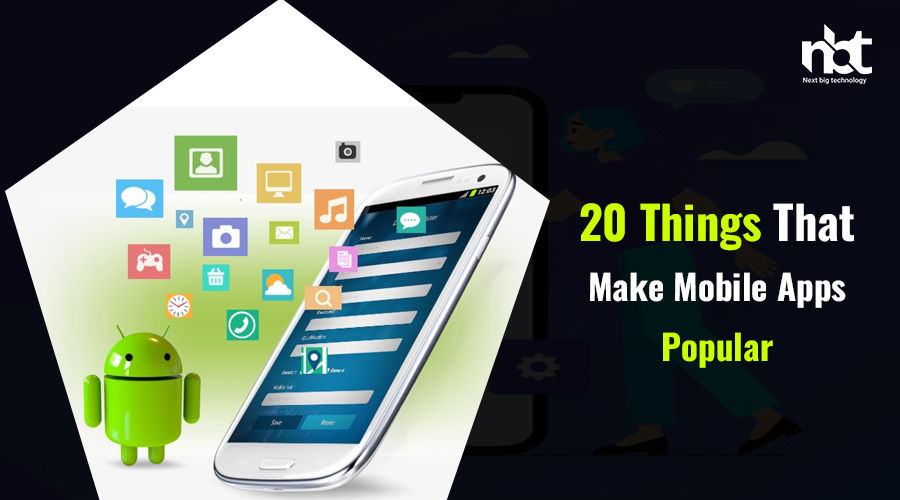Introduction: In the dynamic world of mobile apps, popularity plays a vital role in determining an app’s success. With millions of apps available in app stores, standing out and capturing users’ attention is crucial. In this blog, we will explore 20 key factors that contribute to the popularity of mobile apps. From user experience to innovative features and effective marketing strategies, understanding these elements will help app developers create apps that resonate with users and achieve widespread popularity.
- Intuitive User Interface (UI): An intuitive UI ensures that users can easily navigate and interact with the app. A clean and visually appealing design, consistent layout, and logical flow enhance the overall user experience and make the app more user-friendly.
- Seamless User Experience (UX): A seamless UX involves minimizing friction points and providing a smooth and enjoyable experience for users. This includes fast loading times, quick responses, easy-to-understand instructions, and intuitive gestures.
- High Performance: Apps that deliver high performance, with minimal lag or crashes, are more likely to gain popularity. Optimizing the app’s code, using efficient algorithms, and conducting thorough testing contribute to a smooth user experience.
- Unique Value Proposition: A unique value proposition sets an app apart from its competitors. Apps that solve specific problems, offer innovative features, or cater to niche markets have a higher chance of gaining popularity due to their distinctiveness.
- Rich Content: Providing high-quality and engaging content is crucial for app popularity. Whether it’s informative articles, entertaining videos, or interactive elements, apps that offer valuable content keep users engaged and coming back for more.
- Personalization: Apps that allow users to personalize their experiences by customizing settings, preferences, or content recommendations gain popularity. Personalization enhances user engagement and creates a sense of ownership.
- Social Integration: Integrating social media features allows users to share app content, invite friends, or connect with other users. Social integration not only facilitates user engagement but also increases the app’s visibility through word-of-mouth marketing.
- Gamification: Adding gamification elements, such as badges, leaderboards, or rewards, can make an app more engaging and addictive. Gamification encourages user participation, competition, and a sense of achievement, which contribute to app popularity.
- Offline Accessibility: Apps that offer offline accessibility, allowing users to access certain features or content without an internet connection, provide convenience and enhance user experience. This is particularly useful for apps that involve reading, note-taking, or task management.
- Regular Updates and Bug Fixes: Frequent updates that introduce new features, improvements, and bug fixes demonstrate a commitment to providing a quality app experience. Regular updates keep users engaged and ensure the app stays relevant in a rapidly evolving digital landscape.
- Cross-Platform Compatibility: Apps that are available on multiple platforms, such as iOS and Android, reach a wider audience and increase their chances of popularity. Cross-platform compatibility ensures that users can access the app regardless of their device preference.
- Seamless Onboarding Process: A seamless onboarding process is crucial for user retention. Apps that provide a clear and guided introduction, interactive tutorials, and easy account setup enhance the initial user experience and encourage continued usage.
- Integration with Device Features: Apps that leverage device features such as GPS, camera, accelerometer, or voice recognition enhance functionality and offer unique experiences. Leveraging these features intelligently can make an app more appealing and popular.
- Push Notifications: Well-timed and relevant push notifications help keep users engaged and remind them about the app’s value. Notifications should be personalized, non-intrusive, and offer value to the user, such as updates, reminders, or exclusive offers.
- User Feedback and Support: Apps that actively seek user feedback and provide prompt customer support create a positive user experience. Actively listening to users, addressing their concerns, and continuously improving the app based on feedback enhances user satisfaction and drives popularity.
- Security and Privacy: Ensuring the security and privacy of user data is essential for app popularity. Apps that prioritize data encryption, secure authentication, and transparent privacy policies build trust among users, contributing to their popularity.
- App Store Optimization (ASO): Optimizing the app’s visibility in app stores through ASO techniques, such as keyword optimization, compelling descriptions, appealing screenshots, and positive reviews, increases the likelihood of discovery and download.
- Seamless Payment Integration: Apps that provide a seamless and secure payment experience, supporting various payment methods, contribute to user satisfaction and encourage in-app purchases. Smooth payment integration enhances the overall app experience.
- Influencer Marketing: Partnering with influencers or industry experts to promote the app can significantly boost its visibility and popularity. Collaborating with influencers who have a relevant audience can create a buzz around the app and drive downloads.
- Effective Marketing and Promotion: Implementing a comprehensive marketing strategy, including social media campaigns, content marketing, online advertisements, and app review websites, helps increase app visibility and drives user acquisition. A well-executed marketing plan is crucial for app popularity.
Conclusion: The popularity of mobile apps relies on a combination of factors, including intuitive UI, seamless UX, unique value proposition, engaging content, personalization, social integration, gamification, offline accessibility, regular updates, cross-platform compatibility, and more. By understanding these elements and incorporating them strategically into app development and marketing strategies, developers can increase the chances of creating an app that resonates with users and achieves widespread popularity. Remember, consistently delivering a great user experience and actively listening to user feedback are key to maintaining and growing app popularity over time.









